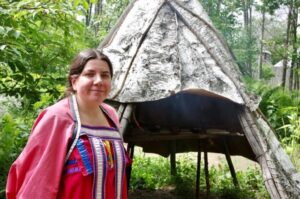Fort William Historical Park’s Anishinaabe Keeshigun gathering focuses on giving youth a voice

THUNDER BAY — Presentations by three Fort William First Nation citizens on the Anishinabe Encampment, giving youth a voice and Water Walks were featured at Fort William Historical Park’s (FWHP) Anishinaabe Keeshigun gathering on Aug. 20-21. The free gathering included entertainment, hands-on activities and demonstrations that showcased Anishinabek culture, traditions, language, and technology.
Waabshkimiigwankwe, from Anemki Wajiw (FWHP historical identity), highlighted some of the features of the Anishinabe Encampment at FWHP, including the cookhouse where she was smoking fish.
“We’re smoking fish — I’ve tried smoked fish before and it’s really good,” Waabshkimiigwankwe says. “I just added another piece of wood. It could take hours to smoke.”
Waabshkimiigwankwe says the cookhouse, which is built like a small tipi, is used for smoking fish and meat on a rack and making bannock over the fire.
“Coming to [FWHP] is like taking a walk in the past, so we’re showing people how we lived,” Waabshkimiigwankwe says.
Danika Lee Banning, vice president of coordination at the Regional Multicultural Youth Council (RMYC) and Fort William citizen, highlighted some of the RMYC’s programs during the gathering.
“Our main goals are to give youth a voice to keep them safe and to help them graduate,” Banning says. “We want to make an impact on youth because nowadays they struggle and they want to drop out of school, but we’re willing to take the extra mile to be there for them and support them, give them housing and help them with food.”
Banning says many of the visitors already knew about the RMYC, which has been in operation since 1985.
“They asked us about our Youth Power and how young we take kids because we go to ages of three all the way to 16 to 20,” Banning says.
Fort William Elder Sheila DeCorte, one of the For Love of the Rivers 2.0 Water Walk 2022 Water Walkers, highlighted during the gathering’s pow wow how she was inspired to do Water Walks in the Thunder Bay area after participating in the late Water Walker Josephine Mandamin’s last Water Walk in 2017.
“What inspired me was the call from the rivers, the river spirits that live in the rivers here in Thunder Bay,” DeCorte says. “I felt strongly that these rivers were hurting and in a lot of pain because of the many Indigenous youth that would come to our city to go to school and they were being found in these rivers.”
DeCorte says she had a vision to bring water down from Loch Lomond, which is located on Anemki Wajiw, for the Water Walk ceremonies and add it into the rivers.
“But before I did that, I needed to consult and speak with our grandmother Josephine Mandamin to get her support and her advice,” DeCorte says. “She told me I needed to do it for four years, but because it was very difficult to get up there that first year, we decided to do the four directions. So I met my vision to bring the water down from Loch Lomond through ceremony and add the water to the rivers.”
The gathering included opportunities for visitors to sample some popped manomin (wild rice), bakwezhigan (fry bread), and corn-on-the-cob and to participate in some traditional activities and games such as atlatl (spear throwing), baggataway (lacrosse), and double ball. Demonstration areas were also set up for wood spoon carving and canoe building.
“Fort William Historical Park is delighted to expand its daily activities and demonstrations that highlight Anishinaabe culture, traditions, language, and technology at Anishinaabe Keeshigun,” says Patrick Morash, general manager at FWHP.


